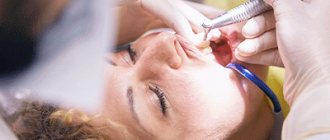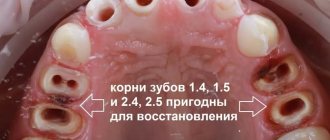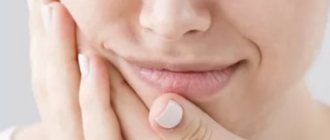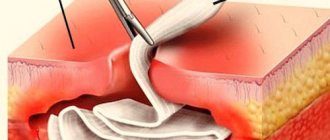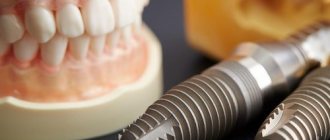05.08.2021 956
There are a large number of reasons why a person could potentially suffer such an injury. In this case, there can be a lot of unpleasant consequences - from a simple violation of aesthetics to severe pain, hypersensitivity to cold or hot food.
Let's look at why chips may appear and what the consequences are. We will also touch upon the issue of prompt home treatment in such a situation, as well as a method for solving the problem by a professional dentist.
The most common causes of chipped teeth
Human teeth are very strong. They are well protected from external mechanical influences and are designed specifically to cope with tough, fibrous foods. However, there are many factors that could potentially lead to chipping.
When you make an appointment with your dentist, he or she will conduct a thorough examination of your mouth and determine what may be causing the problem.
Typically, chips occur as a result of several common reasons:
- Inattentive food selection. You can chip a tooth when chewing if there is something too hard inside the food. It could be a small stone, a mollusk shell, and much more. The danger is especially great if you actively chew food and cannot sense in time that something is wrong.
- External trauma. Often happens when hit, fallen, or involved in a traffic accident. There is also a danger of collateral injuries. This may include tooth dislocation, gum damage, wounds on the tongue, or the oral mucosa.
It is also important to understand that the strength of a person's teeth may vary depending on many factors. There are several factors that significantly increase the likelihood of chipping:
- Violation of the acidity of the oral cavity.
- Enamel diseases.
- Cracks on the surface of the tooth.
- Severe damage to the seal.
- Malocclusion and other congenital deformities.
- Bruxism.
People with bad habits are also at risk. Excessive consumption of alcohol and smoking leads to teeth becoming much more fragile.
If a person belongs to a risk group, a chip may appear even from not the strongest pressure. Therefore, it is worth monitoring the condition of your teeth and taking timely measures. So, if you suffer from bruxism and grind your teeth a lot at night, you should choose mouthguards on the advice of your dentist to reduce the negative impact.
Some people also experience chipping simply because they are inattentive to their diet. They actively chew on candy and nuts and open their jaws too much while chewing food, which significantly increases the potential for injury.
Sometimes the problem takes on a systemic nature and indicates negative changes in the body, a lack of certain nutrients from food. In this case, the answer to the question of why teeth may break off specifically in your case is given by a comprehensive examination.
Treatment and restoration options in dentistry
Incisors and canines are more susceptible to accidental injuries, since they are located in the anterior sections of the jaws. But sometimes, under the influence of traumatic factors, the integrity of chewing molars is compromised. More often, they are destroyed as a result of carious processes or constant mechanical impact, for example, due to malocclusion and uneven distribution of load. Treatment will depend on the nature of the damage and its depth.
If a small piece of a molar has chipped off, the defect can be repaired by layer-by-layer application of a light-curing composite. If the injury has affected a significant part of the hard tissues, a restoration insert will help restore the shape.
If there is minor damage, you can install a tab
If the pulp is damaged, it will most likely have to be partially or completely amputated. After removing the nerve, the doctor will clean and fill the canals, install a pin or stump insert if necessary, and then be able to restore the shape using a composite or crown. If there is serious root trauma, the tooth most often has to be completely removed. In such a situation, the optimal solution to the problem would be implantation and prosthetics.
Another alternative is to install a bridge supported by adjacent elements. However, in this case, the supports will bear an increased load, which is why they will soon begin to gradually collapse. Due to the lack of chewing load in the area of the defect, the bone tissue will begin to atrophy, and subsequently, in order to install implants, it will be necessary to first build up the jawbone, and this is an expensive procedure1.
Signs of chipping
In most cases, chips can be identified by visual inspection or when the patient simply touches the tooth with his tongue. But there are also situations when the chip is located on the inside, difficult to reach and difficult to inspect.
Such situations reveal themselves as a whole list of symptoms. These include the following:
- Problems with chewing food, something constantly gets in the way, pieces begin to get stuck inside the tooth.
- The loss of a previously installed filling (a chip forms on the remaining part of the tooth and it simply cannot hold on normally).
- Severe sensitivity when eating - a reaction occurs to sour, salty, cold, hot foods.
- Acute pain and severe pulsation at the site of injury.
It is worth understanding that the size and nature of chips may vary. Because of this, some patients may not even notice the problem, while others experience severe pain - their nerve is exposed. Regardless of the degree of destruction, you should consult a doctor as soon as possible and conduct a detailed examination of the oral cavity.
Types of chips and characteristic symptoms
Experts in the field of dentistry distinguish several types of chips, which differ from each other in the nature and depth of damage. An enamel chip is a minor violation of the integrity of the crown, for example, when a small piece of the cutting edge breaks off. With such damage, patients usually do not experience pain or even discomfort. But such a defect may well affect the aesthetics, especially if it falls into the smile zone. In addition, if you ignore the problem, the tooth will continue to decay over time.
Dentin damage is usually diagnosed when the wall of a tooth near the gum, a piece of an incisor, or even half of a crown breaks off. It is much more serious if a deep chip affects a large part of the crown or, for example, leads to its vertical fracture. In this case, the person inevitably faces severe pain, and emergency dental care is required. If the root is damaged, complete removal will have to be carried out.
The photo shows damage to the dentin of the tooth.
Main types of damage
The choice of treatment method directly depends on how badly the patient’s tooth is damaged. There are several common manifestations, which include the following:
Crack in the enamel.
- The enamel itself is very durable, which is not surprising - it acts as the main protective mechanism throughout life. There are many factors that can lead to the appearance of microcracks in the surface. From the outside, they are often very difficult to distinguish, but they can not only increase in size, but also become the cause of common oral diseases, such as caries. Food gets packed into the cracked areas and bacteria actively multiply in them. At the same time, the strength becomes less and the likelihood of a large chip only increases. The standard cause of the problem is an incorrect diet, eating a lot of sweets.
- Chipping of part of the enamel. A lacuna appears on the tooth, which is often clearly visible even during an external examination. There is pain and an acute reaction when eating various types of food. It is worth consulting a doctor as soon as possible to prevent the problem from getting worse.
- Skol. It differs in location and size. Depending on the nature of the injury, it appears on both the external and internal sides of the tooth and is clearly visible during the initial visual examination. The injury is accompanied by hypersensitivity, severe pain, pulsation and other noticeable negative manifestations.
Injuries in which the tooth is chipped at the root are also common. They are the most dangerous for humans, because in this case the nerve is exposed and the patient begins to experience severe physical suffering. Further actions in case of injury will depend on the condition of the remaining part of the tooth. Removal of the root is required, but sometimes it is possible to use the remainder as a base for a crown.
In our clinic, doctors fight for every tooth. We do everything to restore aesthetics, chewing ability and relieve you of pain.
First aid at home for a chipped tooth
Sometimes the injury occurs late in the evening or it is impossible to make an appointment with a doctor the next day. In this case, you need to take the right steps to prevent infection, relieve pain, and rule out most other potential problems.
At home, several actions are taken depending on how severe your injury is and what signs it is accompanied by:
- Mouth rinse. Note that as soon as a tooth chips, you need to stop swallowing saliva until you rinse your mouth. Rinsing is done gently, without creating a vacuum or strong pressure on the affected side. To ensure quick disinfection, you can also use a chlorhexidine solution.
- Application of a special compress. This is necessary in order to minimize swelling. At home, use a towel soaked in cold water or a special ice bag, which we recommend keeping on hand. If there is no such bag, put the ice in a bag and wrap it with cloth. The same towel will work well.
- Taking painkillers. This allows for temporary relief of pain. If you do not have any contraindications, you can use products with an additional anti-inflammatory effect. These include such as Ibuprofen, Dolaren and others. When the patient does not have individual intolerance to drugs, and the chip is large, it is practiced to place a tampon soaked in lidocaine or novocaine inside. The measure is needed to significantly reduce pain and prevent pathogenic bacteria from entering the chipped tooth.
A special situation arises if a person experiences severe bleeding. In this case, rinsing is contraindicated. The tooth itself can be covered with a turunda for additional protection.
If you have a chip, you need to see a doctor as soon as possible. When a tooth is chipped at the root, we recommend saving the remaining part - it will be needed for subsequent restorative procedures.
It is not recommended to delay going to the doctor. The reason is that there is a high probability of infection and gradual further spread of the process.
Types of professional medical care
When a patient sees a dentist, he carefully assesses the situation. Depending on the initial state, there may be many options for action. These include:
- Remineralization. This method is used if a small crack occurs in the enamel. Either an individual tooth or the entire row can be treated with a special strengthening preparation. A special product is used, which contains a sufficient amount of various trace elements and minerals. The technology allows you to get rid of cracks and significantly strengthen the tooth.
- Application of preparations with a high fluoride content. This is also necessary in order to significantly improve the overall condition of the enamel. The patient is prescribed a special mouthguard, onto which such material is applied. This makes it possible to provide treatment around the clock.
- Artistic restoration. This method is needed specifically to restore the aesthetics of the oral cavity. The method is used if the chip is small. Modern technologies are needed to restore the shine of enamel. The color of the restored fragment will not differ from the surrounding row.
- Installation of additional cover. One of the most common methods of restoring dental aesthetics without the use of complex and lengthy operations. We use various types of overlays – these can be lumineers and veneers. The composition, duration of use, appearance and many other characteristics differ.
- Placement of a special crown. The approach can be used if the upper part of the tooth is not severely damaged. The remaining part of the tooth in this case begins to be used as a natural support. The crown will be stable and will completely fill the vacated space.
- Using special tabs. At the same time, the order for the production of such an onlay is transferred to a special dental laboratory. The overlay is very durable and restores chewing ability.
Sometimes, as a result of strong pressure, the tooth root itself breaks. This is the most serious situation in which proper removal of tooth remains and subsequent implantation will be required. A base is installed in the gum, on which a special crown is fixed.
How necessary is treatment?
Treatment of chips is not always necessary.
If we are talking about minor damage, then it is often enough to carry out an inspection, make sure there are no deeper cracks and, if the chipped tooth enamel has sharp edges, grind it. After this, the patient is advised to monitor his oral health more closely so as not to repeat a similar incident. In some cases, if the damage is of moderate severity, additional filling may be required. For this, standard composite materials are used.
Severe enamel damage
If the chip is deep, the doctor may recommend comprehensive treatment. It involves removing the pulp and filling the canals. After this, the cavity is closed with a filling or crown. This approach eliminates the entry of infection and harmful microorganisms into the tooth cavity, thereby keeping it healthy and functional.
Chip in the front row of teeth
Typically, such chips occur when biting or a strong blow. Even the smallest defects are noticeable on the front row, so a small chip can cause not only discomfort, but also psychological problems. Also, the aesthetics are spoiled by microcracks, which over time begin to turn black and become more and more visible.
When small cracks appear, fluoridation and mineralization are usually sufficient. If the enamel has been severely damaged and part of the tooth has broken off, installing an artificial veneer would be a good solution. In our clinic, your dentist will install veneers or ultraneers for you. If the damage is severe, the only option is removal, prosthetics or implantation.
Chip on the side of the tooth
Most often occurs during chewing. Since this is a side invisible to prying eyes, many patients decide not to see a doctor at all and live with such a defect.
This approach is wrong for several reasons:
- A chip can easily become a site for the development of caries and the situation will only get worse.
- Due to the strong pressure on the damaged area, further destruction is possible.
- There is a risk of injury to the tongue when it comes into contact with a sharp edge and the onset of an inflammatory process.
The advantage of working with the sides is that aesthetics matter less. Therefore, you can get by with less expensive materials during the restoration process. The strength itself will not become lower.
Why Teeth Chip – Potential Causes of Injury and Crown Failure
Enamel is considered the hardest tissue in the body. But even chips can appear on it, and there are many possible reasons for this. A chip is an injury in which the integrity of the crown is compromised. The damage may be very minor, even unnoticeable. But in other cases, the chip affects not only the enamel, but also the dentin.
If a tooth breaks off near the gum, such a defect cannot be ignored. Moreover, in case of large-scale damage, the pulp may also be injured, and this will inevitably provoke severe piercing pain - you need to see a doctor as soon as possible.
A chip is an injury in which the integrity of the crown is compromised
As a rule, teeth are injured as a result of mechanical impact. For example, the front incisors and canines are at high risk - they can easily be damaged if you fall or get hit. Molars more often chip off during meals, when chewing solid foods. A cracker, a fish bone, or, for example, a nut shell can injure the chewing crown. However, there are other reasons that can provoke such trouble:
- insufficient hygiene, abundant plaque and hardened deposits - the active activity of pathogenic microorganisms in this case leads to the gradual destruction of hard tissues, the development of caries and pulpitis,
- the habit of biting off thread with teeth, cracking nut shells, gnawing seeds,
- demineralization of enamel - as a result of systemic failures within the body, hormonal changes, pathological and age-related changes,
- incorrect bite – leads to uneven distribution of the chewing load, which causes crowns to wear down and chip, which are subject to increased pressure,
- consequences of dental treatment - after depulpation, that is, removal of the nerve, the tooth becomes “dead”. This means that it is deprived of constant replenishment, which is why it darkens and becomes brittle. Therefore, chips on pulpless incisors and molars are not uncommon.
Improper dental treatment can cause a problem.
If the enamel is healthy and strong, it will be quite resistant to mechanical stress, temperature and chemical factors. But if the top protective layer has weakened due to constant traumatic exposure, sudden temperature changes in food and drinks, hormonal imbalances, deficiency of vitamins and microelements, or systemic pathologies, it will be more susceptible to cracks and chips.
Occurrence of a vertical crack
Sometimes a chip does not appear, but the tooth cracks vertically - this is very noticeable from the outside. The choice of treatment method will be based on how severely the enamel is damaged and how deep the crack goes.
There are three main treatment options:
- Standard filling.
- Installation of external onlays on the tooth.
- Removal and subsequent implantation.
It is important to resolve the problem quickly before numerous potential complications arise.
What to do if your tooth chipped?
See a dentist.
The doctor will remove the broken wall, take x-rays of the tooth, and evaluate its safety. If the tooth is not broken much, the root is not damaged or almost not damaged, then it can be restored. Then the tooth is prepared (if necessary, dental canals are treated, caries and old filling materials are cleaned), how badly it is damaged is assessed and the best way to restore it is selected (filling, inlay or crown). If the tooth cannot be saved, it is removed and replaced with an implant or other available method.
Do children need to treat chipped teeth?
Parents often ask the question of what to do if a child’s tooth chips. Many people believe that baby teeth are not that important and therefore need not be treated. The logic is simple - they will fall out on their own and be replaced by indigenous ones.
But you should not be guided by this logic for a simple reason - the condition of the baby tooth greatly affects the formation of the molar. The onset of the inflammatory process and infection of the tooth lead to inflammation of the gums. This can negatively affect the formation of permanent dentition.
Prevention
To prevent chipping of hard tissues, you must adhere to the following rules:
- do not neglect daily cleaning and other hygiene procedures;
- visit the dental clinic every six months for preventive examinations;
- promptly treat caries and other diseases;
- adhere to a proper balanced diet;
- lead a healthy lifestyle, eliminate bad habits;
- if the bite is broken, take measures to correct it;
- minimize the risks of traumatic effects (too hard food is one of the main reasons why a piece of a back tooth breaks off, an incisor or a fang breaks off);
- periodically resort to professional cleaning to remove plaque and stone;
- consult a doctor even if microcracks appear that are not accompanied by unpleasant symptoms.
The dentition is a vulnerable place, especially if you neglect hygiene rules, often chew caramel, smoke, ignore oral diseases and make other mistakes. Chips of the enamel and deeper tissues often lead to serious complications if restoration is not started in time. Before determining what to do if a piece falls off or half of a tooth breaks off, the doctor must determine the extent of the damage and decide whether it is possible to restore the dental unit without resorting to the last resort - extraction.
What complications can you encounter due to chips?
If you notice a chip on your tooth, you should contact your dentist as soon as possible to have it repaired. And it's not just about aesthetics. Delay will cost the health of your smile. There are several potential complications that have to be encountered in medical practice:
- Tooth infection. Any pathogenic bacteria can penetrate through the open pulp. As a result, the person not only suffers from pain. Previously, only a slightly damaged tooth that could still be saved had to be removed.
- Periodontitis. This is the name of a strong inflammatory process that occurs in the tissues surrounding the apex of the tooth root. Treatment is long and complex and may require removal.
- Formation of neoplasm. They can be of either granulosa or cystic type and pose a serious danger to the human body.
- Changes in bite and dental mobility. It is formed due to the fact that it becomes inconvenient for a person to close his jaws. There are many types of complications due to this reason.
The development of severe sensitivity to food, which over time develops into pain, is also characteristic. You cannot delay treatment - contact a doctor as soon as possible.
What does inaction lead to - potential complications
As mentioned above, even a small chip can eventually turn into a serious crack or cavity. Failure to resolve this dental problem in a timely manner can easily result in a whole series of unpleasant consequences. Among the most common complications after such injuries, experts identify the following pathological phenomena:
- damage to dentin and pulp, development of pulpitis, acute pain, the need to remove the nerve or even the entire tooth,
- hyperesthesia - thinning of the enamel and its increased sensitivity to any external irritants,
- fracture of the crown, root, inflammation of the periodontal tissues – periodontitis,
- violation of the correct closure of the jaws and uneven distribution of the load,
- stomatitis as a result of constant injury to the mucous membrane by the sharp edges of the crown,
- cysts and granulomas, suppuration as a result of the inflammatory process.
If you experience any unpleasant symptoms, you should contact a specialist.
You should visit a dentist as soon as you notice a defect. If necessary, the doctor will refer you for an X-ray examination to accurately exclude all of the above-described consequences. And to reduce the risk of chipping, you need to take care of your teeth, maintain a healthy and clean oral cavity, periodically strengthen the enamel with the help of specialized hygiene products, and regularly visit the dentist twice a month for preventive maintenance.
1Iroshnikova E.S. Factors influencing the effectiveness of orthopedic treatment of patients, 2005.
How to prevent chipping
There are several tips that dentists give to patients in order to keep their teeth intact for as long as possible. These include:
- Maintain good oral hygiene. Use high-quality pastes, rinses, special gels as recommended by your doctor. The enamel needs to be strengthened.
- Visit your dentist regularly. It is necessary to carry out proper dental treatment, to ensure that the enamel does not crack or wear off.
- Monitor the condition of the gastrointestinal tract and other body systems. Particular attention should be paid to the functioning of the endocrine and immune systems. Changes in the balance of acidity in the oral cavity should not be allowed.
- Form your diet correctly. It should include foods that stimulate strong bones and teeth.
- Correct your bite. Due to improper bite, chips appear quite often, and the enamel itself is worn away ahead of time. It is cheaper to get braces than to periodically spend money on veneers, implantation, remineralization and other dental procedures.
- Cure bruxism. This may require you to wear special mouthguards.
Equally important is the advice to monitor what and how you eat. Try not to chew on anything too hard—candy, nuts, and more. If you chew carefully and watch what you eat, the likelihood of chipping will be much less.
Reasons for the development of pathology
Damage can be caused by several direct or indirect factors. Determining the cause is an important aspect for proper treatment. Among these factors:
- Mechanical damage due to trauma.
- Chipping due to bad habits (biting nails, pens, and other objects not intended for this purpose).
- Reduced acidity of the oral cavity, which negatively affects the strength of enamel.
- Bite defects.
- Dental pathologies that have not received treatment.
- Remineralized enamel.
- Hormonal imbalances, changes during pregnancy.
- Frequent consumption of excessively hot or cold foods.
- Night grinding of teeth.
We will quickly and efficiently deal with chipped teeth
At our clinic, doctors are ready to quickly treat chipped teeth and any other injuries or damage. We use advanced techniques - from remineralization to installation of onlays and implantation.
We offer our clients affordable prices and are always ready to answer any questions they may have. We will relieve you of pain, restore the aesthetics of your smile and the ability to chew normally. We have affordable prices and special offers.
To learn more about the treatment process and make an appointment with a dentist at a convenient time, leave a request on the website or call us at the numbers provided.


